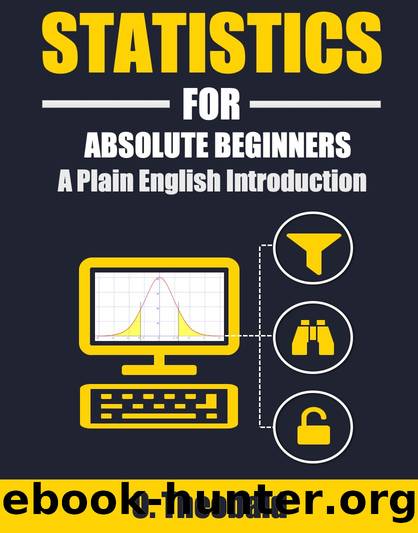Statistics for Absolute Beginners: A Plain English Introduction by O. Theobald

Author:O. Theobald [Theobald, O.]
Language: eng
Format: azw3
Published: 2017-09-27T16:00:00+00:00
Figure 15: Example of Type I and Type II Errors in hypothesis testing
The first mistake is a Type I Error, which is the rejection of a null hypothesis (H0 ) that was true and should not have been rejected. This means that although the data appears to support that a relationship is responsible, the covariance (a measurement of how related the variance is between two variables) of the variables is occurring entirely by chance. Again, this does not prove that a relationship doesn’t exist, merely that it’s not the most likely cause. This is commonly referred to as a false-positive .
Conversely, a Type II Error is accepting a null hypothesis that should’ve been rejected because the covariance of variables was probably not due to chance. This is also known as a false-negative .
Let's use a pregnancy test as an example. In this scenario, the null hypothesis (H0 ) holds that the woman is not pregnant. The null hypothesis is therefore rejected if the woman is pregnant (H0 is false) and accepted if the woman is indeed not pregnant (H0 is true).
Download
This site does not store any files on its server. We only index and link to content provided by other sites. Please contact the content providers to delete copyright contents if any and email us, we'll remove relevant links or contents immediately.
Modelling of Convective Heat and Mass Transfer in Rotating Flows by Igor V. Shevchuk(6408)
Weapons of Math Destruction by Cathy O'Neil(6220)
Factfulness: Ten Reasons We're Wrong About the World – and Why Things Are Better Than You Think by Hans Rosling(4715)
A Mind For Numbers: How to Excel at Math and Science (Even If You Flunked Algebra) by Barbara Oakley(3262)
Descartes' Error by Antonio Damasio(3250)
Factfulness_Ten Reasons We're Wrong About the World_and Why Things Are Better Than You Think by Hans Rosling(3218)
TCP IP by Todd Lammle(3158)
Fooled by Randomness: The Hidden Role of Chance in Life and in the Markets by Nassim Nicholas Taleb(3083)
Applied Predictive Modeling by Max Kuhn & Kjell Johnson(3043)
The Tyranny of Metrics by Jerry Z. Muller(3032)
The Book of Numbers by Peter Bentley(2935)
The Great Unknown by Marcus du Sautoy(2664)
Once Upon an Algorithm by Martin Erwig(2625)
Easy Algebra Step-by-Step by Sandra Luna McCune(2606)
Lady Luck by Kristen Ashley(2556)
Police Exams Prep 2018-2019 by Kaplan Test Prep(2517)
Practical Guide To Principal Component Methods in R (Multivariate Analysis Book 2) by Alboukadel Kassambara(2515)
All Things Reconsidered by Bill Thompson III(2374)
Linear Time-Invariant Systems, Behaviors and Modules by Ulrich Oberst & Martin Scheicher & Ingrid Scheicher(2348)
